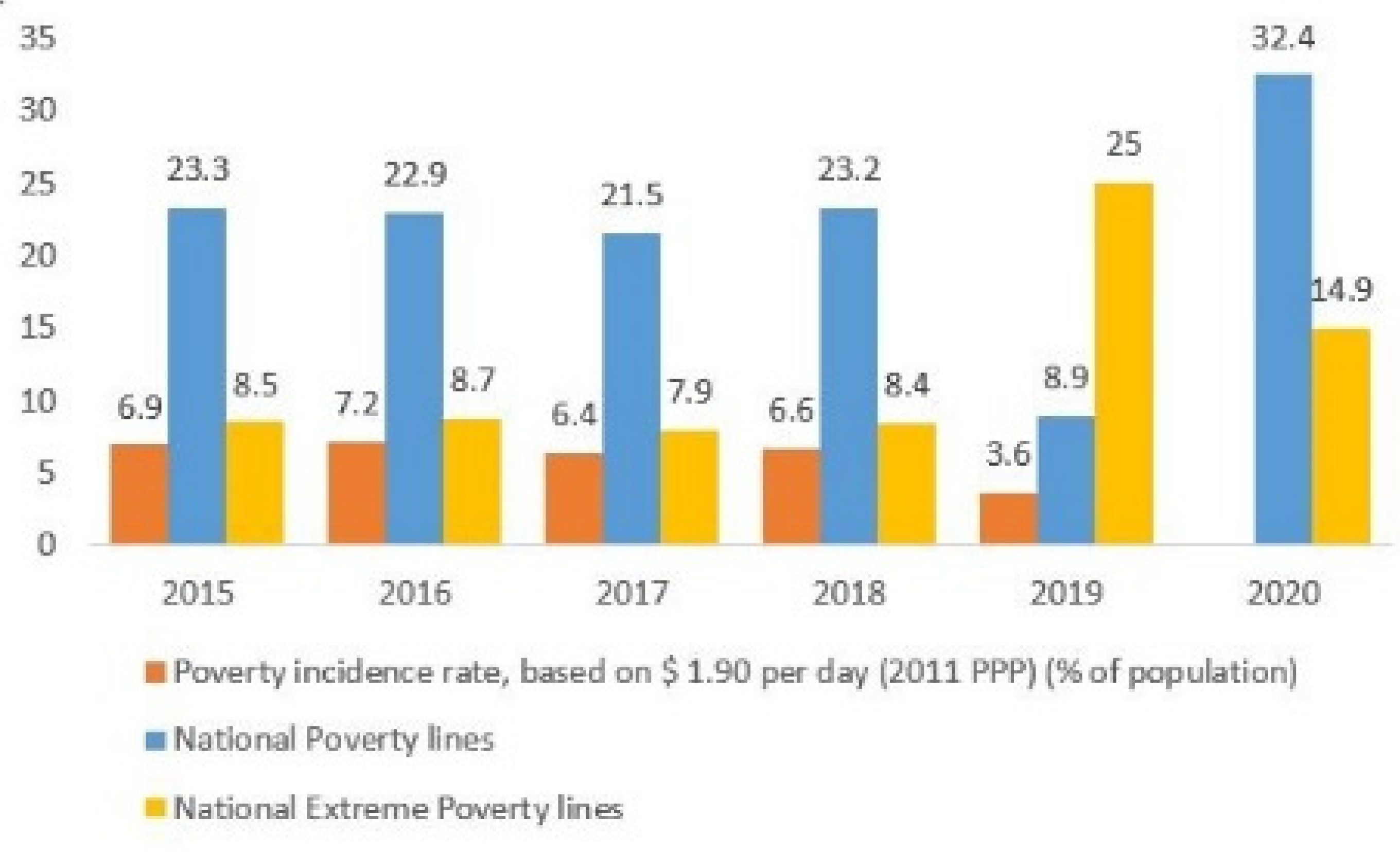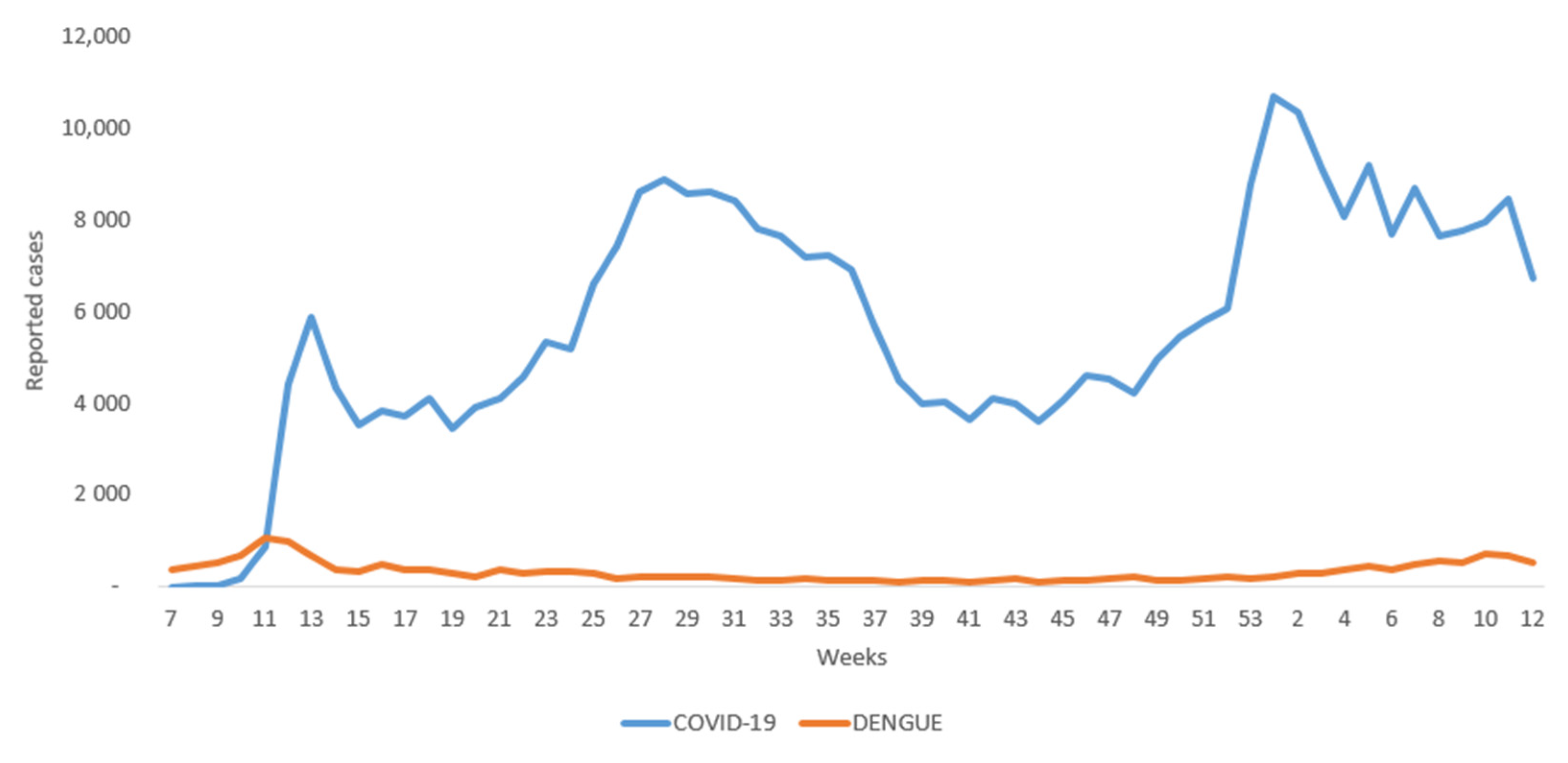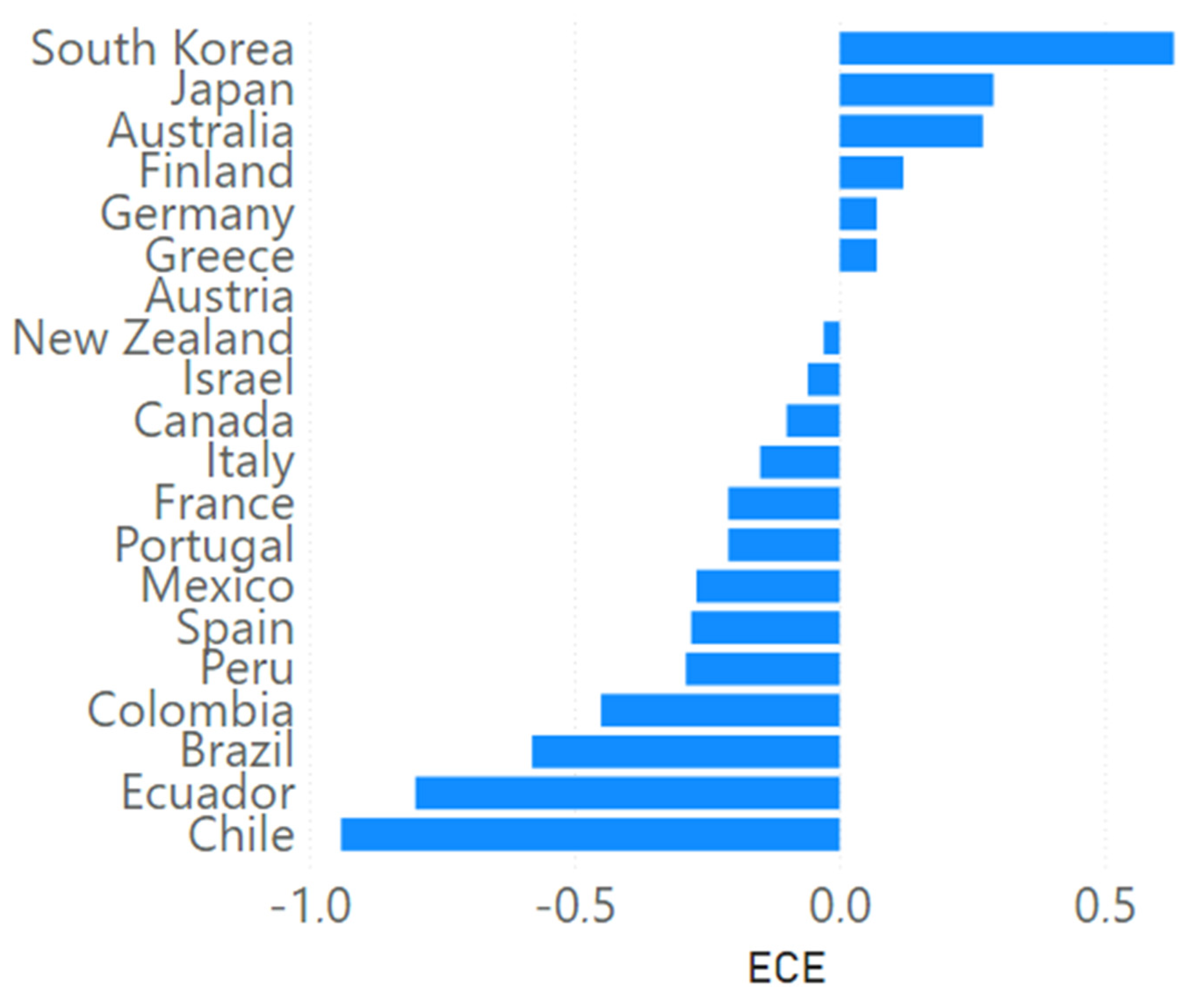Review of Impacts on Sustainable Development in Ecuador of the COVID-19 Pandemic and Lockdown Measures †
Abstract
:1. Introduction
2. Methodology
3. Results
3.1. SDG 1
3.2. SDG 3
3.3. SDG 4
3.4. SDG 8
4. Discussion
4.1. Impacts on SDG 1
4.2. Impacts on SDG 3
4.3. Impact on SDG 4
4.4. Impacts on SDG 8
5. Conclusions
Author Contributions
Funding
Institutional Review Board Statement
Informed Consent Statement
Data Availability Statement
Conflicts of Interest
References
- World Health Organization. Addressing Human Rights as Key to the COVID-19: Response, 21 April 2020; World Health Organization: Geneva, Switzerland, 2020. [Google Scholar]
- SENPLADES. Examen Nacional Voluntario Ecuador. 2020. Available online: https://www.planificacion.gob.ec/ecuador-presento-su-examen-nacional-voluntario-sobre-el-cumplimiento-de-la-agenda-2030/ (accessed on 1 March 2021).
- Dong, E.; Du, H.; Gardner, L. An interactive web-based dashboard to track COVID-19 in real time. Lancet Infect. Dis. 2020, 20, 533–534. [Google Scholar] [CrossRef]
- Pan American Health Organization. Ecuador Receives Its First COVID-19 Vaccines through the COVAX Facility. 2021. Available online: https://www.paho.org/en/news/17-3-2021-ecuador-receives-its-first-covid-19-vaccines-through-covax-facility (accessed on 20 March 2021).
- Ritchie, H.; Ortiz, E.; Beltekian, D.; Mathieu, E.; Hasell, J.; Macdonald, B.; Giattino, C.; Appel, C.; Rodés, L.; Roser, M. Coronavirus Pandemic (COVID-19). Available online: https://ourworldindata.org/coronavirus (accessed on 1 March 2021).
- The Sustainable Development Goals and COVID-19. Sustainable Development Report. 2020. Available online: https://unstats.un.org/sdgs/report/2020/ (accessed on 1 March 2021).
- Caicedo-Ochoa, Y.; Rebellón-Sánchez, D.E.; Peñaloza-Rallón, M.; Cortés-Motta, H.F.; Méndez- Fandiño, Y.R. Effective Reproductive Number estimation for initial stage of COVID-19 pandemic in Latin American Countries. Int. J. Infect. Dis. 2020, 95, 316–318. [Google Scholar] [CrossRef] [PubMed]
- Organization for Economic Co-operation and Development. Development Co-operation Report 2020; OECD: Paris, France, 2020; pp. 1–328. [Google Scholar] [CrossRef]
- Fernández-Naranjo, R.P.; Vásconez-González, E.; Simbaña-Rivera, K.; Gómez-Barreno, L.; Izquierdo-Condoy, J.S.; Cevallos-Robalino, D.; Ortiz-Prado, E. Statistical data driven ap proach of COVID-19 in Ecuador: R0 and Rt estimation via new method. Infect. Dis. Model. 2021, 6, 232–243. [Google Scholar] [CrossRef] [PubMed]
- COVID 19-Google Global Mobility Report. Available online: https://datastudio.google.com/u/0/reporting/a529e043-e2b9-4e6f-86c6-ec99a5d7b9a4/page/yY2MB?s=ho2bve3abdM (accessed on 1 March 2021).
- Dirección Nacional de Síntesis Macroeconómica; Subgerencia de Programación y Regulación. Reporte de pobreza, ingreso y desigualdad. 2020. Available online: https://contenido.bce.fin.ec/documentos/Estadisticas/SectorReal/Previsiones/IndCoyuntura/Empleo/PobrezaDic2020.pdf (accessed on 1 March 2021).
- Banco Central del Ecuador. Indicadores Socioeconómicos Internacionales. 2019. Available online: https://contenido.bce.fin.ec/documentos/Administracion/bi_menuIntegracionRegional.html (accessed on 1 March 2021).
- Moreno Garcés, L. Decreto Ejecutivo No. 1022. 2020. Available online: https://www.propiedadintelectual.gob.ec/covid_19/files/Decreto_Ejecutivo_No._1022_20200227194449.pdf (accessed on 1 March 2021).
- Comité de Operaciones de Emergencia Nacional, C. Informe de Situación COVID-19 Ecuador 2020. 2021. Available online: https://www.gestionderiesgos.gob.ec/informes-de-situacion-covid-19-desde-el-13-de-marzo-del-2020/ (accessed on 1 March 2021).
- Ministerio de Salud Pública. Gacetas epidemiológicas. Available online: https://www.salud.gob.ec/gacetas-epidemiologicas-gaceta-general-2020/ (accessed on 1 March 2021).
- Vitale, M.; Lupone, C.D.; Kenneson-Adams, A.; Ochoa, R.J.; Ordoñez, T.; Beltran-Ayala, E.; Endy, T.P.; Rosenbaum, P.F.; Stewart-Ibarra, A.M. A comparison of passive surveillance and active cluster-based surveillance for dengue fever in southern coastal Ecuador. BMC Public Health 2020, 20, 1065. [Google Scholar] [CrossRef] [PubMed]
- Ministerio de Salud Pública. Gacetas Vectoriales. 2020. Available online: https://www.salud.gob.ec/gacetas-vectoriales/ (accessed on 1 March 2021).
- Ministerio de Salud. Enfermedades transmitidas por vectores Ecuador SE 03–2021. 2021. Available online: https://www.salud.gob.ec/wp-content/uploads/2021/01/Vectores-SE-03.pdf (accessed on 1 March 2021).
- Centers for Disease Control. Dengue and COVID-19. 2020. Available online: https://www.cdc.gov/dengue/is-it-dengue-or-covid.html (accessed on 1 March 2021).
- Navarro, J.C.; Arrivillaga-Henríquez, J.; Salazar-Loor, J.; Rodriguez-Morales, A.J. COVID-19 and dengue, co-epidemics in Ecuador and other countries in Latin America: Pushing strained health care systems over the edge. Travel Med. Infect. Dis. 2020, 37, 101656. [Google Scholar] [CrossRef] [PubMed]
- España, I.G.; Gómez, M.C. Análisis de la relación COVID-19 y dengue dentro de la época de pandemia marzo a mayo en el Ecuador. Univ. Y Soc. 2020, 12, 261–268. [Google Scholar]
- Centers for Disease Control. Coronavirus Disease 2019 (COVID-19)-Symptoms. 2021. Available online: https://www.cdc.gov/dotw/covid-19/index.html#:~:text=Key%20Facts,fever%2C%20chills%2C%20and%20cough. (accessed on 1 March 2021).
- Frantchez, V.; Fornelli, R.; Sartori, G.P.; Arteta, Z.; Cabrera, S.; Sosa, L.; Medina, J. Dengue en adultos: Diagnóstico, tratamiento y abordaje de situaciones especiales. Rev. Med. Del Urug. 2016, 32, 43–51. [Google Scholar]
- Yan, G.; Lee, C.K.; Lam, L.T.; Yan, B.; Chua, Y.X.; Lim, A.Y.; Phang, K.F.; Kew, G.S.; Teng, H.; Ngai, C.H.; et al. Covert COVID-19 and false-positive dengue serology in Singapore. Lancet Infect. Dis. 2020, 20, 536. [Google Scholar] [CrossRef] [Green Version]
- Joob, B.; Wiwanitkit, V. COVID-19 can present with a rash and be mistaken for dengue. J. Am. Acad. Dermatol. 2020, 82, e177. [Google Scholar] [CrossRef]
- Ortiz-Prado, E.; Henriquez-Trujillo, A.R.; Rivera-Olivero, I.A.; Freire-Paspuel, B.; Vallejo- Janeta, A.P.; Lozada, T.; Garcia-Bereguiain, M.A. Massive SARS-CoV-2 RT-PCR Testing on Rural Communities in Manabi Province (Ecuador) Reveals Severe COVID-19 Outbreaks. Am. J. Trop. Med. Hyg. 2021, 104, 1493–1494. [Google Scholar] [CrossRef]
- Barre Sarango, J.P.; Castro Chugá, C.L. Deserción educativa generada a raíz de la cuarentena obligatoria durante la pandemia del COVID-19, en estudiantes de básica elemental y media en la ciudad de Quito. Master Thesis, Universidad Central del Ecuador, Quito, Ecuador, 2021. [Google Scholar]
- Pachay-López, M.J.; Rodríguez-Gámez, M. La deserción escolar: Una perspectiva compleja en tiempos de pandemia. Polo Del Conoc. 2021, 6, 130–155. [Google Scholar]
- Peña, M.A.; Herrera, L. Indicadores de tecnología de la información y comunicación. 2021. Available online: https://www.ecuadorencifras.gob.ec/documentos/web-inec/Estadisticas_Sociales/TIC/2020/202012_Boletin_Multiproposito_Tics.pdf (accessed on 1 March 2021).
- Fondo de las Naciones Unidas para la Infancia (UNICEF). COVID-19: Más del 95 por ciento de niños, niñas y adolescentes está fuera de las escuelas en América Latina y el Caribe. 2020. Available online: https://www.unicef.org/lac/comunicados-prensa/covid-19-mas-del-95-por-ciento-de-ninos-y-ni%C3%B1as-esta-fuera-de-las-escuelas (accessed on 1 March 2021).
- Ministerio de Educación. Estadísticas educativas-Datos Abiertos–Ministerio de Educación. Available online: https://educacion.gob.ec/datos-abiertos/ (accessed on 1 March 2021).
- Sanahuja, J.A. COVID-19 en América Latina: La economía política de las respuestas gubernamentales. Pensam. Iberoam. 2020, 3, 22–33. [Google Scholar]
- Ministerio de Educación. Plan Educativo: Aprendamos juntos desde casa. 2020. Available online: https://recursos2.educacion.gob.ec/wp-content/uploads/2020/05/Plan-Educativo-Aprendamos-Juntos-en-casa.pdf (accessed on 1 March 2021).
- El Ministerio de Educación abre el curso de autoaprendizaje “Mi Aula en Línea”–Ministerio de Educación. Available online: https://educacion.gob.ec/el-ministerio-de-educacion-abre-el-curso-de-autoaprendizaje-mi-aula-en-linea/ (accessed on 1 March 2021).
- Banco Central del Ecuador. Resultados de las Cuentas Nacionales Trimestrales del cuarto trimestre de 2016 y anual 2016. Available online: https://www.bce.fin.ec/index.php/boletines-de-prensa-archivo/item/965-resultados-de-las-cuentas-nacionales-trimestrales-del-cuarto-trimestre-de-2016-y-anual-2016 (accessed on 1 March 2021).
- Banco Central del Ecuador. Ecuador creció 3.0% en 2017 y confirma el dinamismo de su economía. Available online: https://www.bce.fin.ec/index.php/boletines-de-prensa-archivo/item/1080-ecuador-crecio-30-en-2017-y-confirma-el-dinamismo-de-su-economia#:~:text=La%20econom%C3%ADa%20ecuatoriana%20(PIB)%20en,Gobierno%20General%20y%20las%20Exportaciones (accessed on 1 March 2021).
- Banco Central del Ecuador. La economía ecuatoriana decreció -0.1% en el tercer trimestre de 2019. Available online: https://www.bce.fin.ec/index.php/boletines-de-prensa-archivo/item/1339-la-econom%C3%ADa-ecuatoriana-decreci%C3%B3-01-en-el-tercer-trimestre-de-2019 (accessed on 1 March 2021).
- Banco Central del Ecuador. La pandemia incidió en el crecimiento 2020: La economía ecuatoriana decreció 7.8%. Available online: https://www.bce.fin.ec/index.php/boletines-de-prensa-archivo/item/1421-la-pandemia-incidio-en-el-crecimiento-2020-la-economia-ecuatoriana-decrecio-7-8#:~:text=Esto%20fue%20determinante%20para%20que,de%20las%20cuentas%20nacionales%20trimestrales (accessed on 1 March 2021).
- Lenin, M.G. Decreto Ejecutivo No 1074-2020-ESTADO DE EXCEPCION. 2020. Available online: https://www.uta.edu.ec/v3.2/uta/reglamentosexternos/Decreto%20Eecutivo%20No%201074-2020-ESTADO%20DE%20EXCEPCION.pdf (accessed on 1 March 2021).
- Instituto Nacional de Encuestas y Censos. Encuesta Nacional de Empleo, Desempleo y Subempleo (ENEMDU)- Indicadores Laborales. 2020. Available online: https://www.ecuadorencifras.gob.ec/documentos/web-inec/EMPLEO/2020/Diciembre-2020/202012_Mercado_Laboral.pdf (accessed on 1 March 2021).
- Heredia Zurita, A.; Marco, D. Análisis de las políticas de apoyo a las pymes para enfrentar la pandemia de COVID-19 en América Latina; Comisión Económica para América Latina y el Caribe (CEPAL): Santiago, Chile, 2021. [Google Scholar]
- Comisión Económica para América Latina y el Caribe. Sectores y empresas frente al COVID-19: Emergencia y reactivación. 2020. Available online: https://www.cepal.org/en/publications/45736-sectors-and-businesses-facing-covid-19-emergency-and-reactivation (accessed on 1 March 2021).
- Torres-Roman, J.S.; Kobiak, I.C.; Valcarcel, B.; Diaz-Velez, C.; Vecchia, C.L. The reproductive number R0 of COVID-19 in Peru: An opportunity for effective changes. Travel Med. Infect. Dis. 2020, 37, 101689. [Google Scholar] [CrossRef] [PubMed]
- Hilton, J.; Keeling, M.J. Estimation of country-level basic reproductive ratios for novel Coronavirus (SARS-CoV-2/COVID-19) using synthetic contact matrices. PLoS Comput. Biol. 2020, 16, e1008031. [Google Scholar] [CrossRef]
- Chaguay, S.L.; Galeas, R.R.; Chaguay, L.A.L. Desempleo en tiempos de COVID-19: Efectos socioeconómicos en el entorno familiar. J. Sci. Res. Rev. Cienc. E Investig. 2020, 5, 187–197. [Google Scholar]
- Stewart Ibarra, A.M.; Ryan, S.J.; Beltrán, E.; Mejía, R.; Silva, M.; Muñoz, Á. Dengue vector dynamics (Aedes aegypti) influenced by climate and social factors in Ecuador: Implications for targeted control. PLoS ONE 2013, 8, e78263. [Google Scholar] [CrossRef]
- Verduyn, M.; Allou, N.; Gazaille, V.; Andre, M.; Desroche, T.; Jaffar, M.C.; Traversier, N.; Levin, C.; Lagrange-Xelot, M.; Moiton, M.P.; et al. Co-infection of dengue and COVID-19: A case report. PLoS Negl. Trop. Dis. 2020, 14, e0008476. [Google Scholar] [CrossRef]
- Portillo, R.T.V.; Uscata, B.A.; Gonzales-Zubiate, F.A.; Medina, K.J.; Sevillano, O.R.; Ramos-Sanchez, E.M. Pruebas rápidas para COVID-19, la mejor alternativa para Ecuador. Bionatura Lat. Am. J. Biotechnol. Life Sci. 2020. [Google Scholar] [CrossRef]
- United Nations Educational, Scientific and Cultural Organization (UNESCO). From Disruption to Recovery. 2021. Available online: https://en.unesco.org/covid19/educationresponse (accessed on 1 March 2021).
- Vivanco-Saraguro, A. Teleducación en tiempos de COVID-19: Brechas de desigualdad. Cienci América 2020, 9, 166–175. [Google Scholar] [CrossRef]
- International Organization of Labor. Observatorio de la OIT: El COVID-19 y el mundo del trabajo. Cuarta Edición 2020, 4, 26. [Google Scholar]
- León, L.; Vargas, K.; Zúñiga, F. Ecuador: Incidencia de la pobreza en el producto interno bruto y desempleo 2000–2018. Rev. Espíritu Emprend. 2020, 19, 1–13. [Google Scholar]
- Arévalo, M.I.; López, M.R.A. Posibles medidas de política económica en el contexto actual y post COVID-19: Caso Ecuador. Sur Acad. Rev. Académica-Investig. De La Fac. Jurídica Soc. Y Adm. 2020, 7, 59–73. [Google Scholar] [CrossRef]
- Correa-Quezada, R.; Vélez, D.G.; García, J.Á.; Castillo, M.d.C.T. La COVID-19 y su impacto en la pobreza de Ecuador: Método de escenarios. Contaduría Y Adm. 2020, 65, 5. [Google Scholar] [CrossRef]



| ERR | R0 | Mobility Reduction | ECE |
|---|---|---|---|
| 3.95 * | 2.4 ** | 67% **** | −1.31 |
| 3.95 * | 2.93 *** | 67% **** | −1.01 |
| Year | Students Enrolled * | Schools * | Teachers * | Schools as Internet Source (%) ** | Households with Internet Access (%) ** |
|---|---|---|---|---|---|
| 2015 | 4,620,397 | 19,000 | 218,109 | 10.01 | 32.80 |
| 2016 | 4,574,350 | 17,000 | 214,478 | 10.79 | 36.03 |
| 2017 | 4,508,457 | 17,000 | 216,876 | 9.29 | 37.20 |
| 2018 | 4,465,240 | 17,000 | 219,406 | 7.21 | 37.17 |
| 2019 | 4,399,567 | 16,000 | 219,540 | 5.15 | 45.54 |
| 2020 | 4,307,554 | 16,000 | 206,448 | 0.47 | 53.21 |
| Year | GDP(%) | GDP per Capita (%) |
|---|---|---|
| 2015 | 0.10 | −1.51 |
| 2016 | −1.23 | −2.90 |
| 2017 | 2.37 | 0.57 |
| 2018 | 1.29 | −0.48 |
| 2019 | 0.05 | −1.61 |
Publisher’s Note: MDPI stays neutral with regard to jurisdictional claims in published maps and institutional affiliations. |
© 2022 by the authors. Licensee MDPI, Basel, Switzerland. This article is an open access article distributed under the terms and conditions of the Creative Commons Attribution (CC BY) license (https://creativecommons.org/licenses/by/4.0/).
Share and Cite
Matamoros Alcivar, E.; de Llano García, D.; Vaca Chanatasig, C. Review of Impacts on Sustainable Development in Ecuador of the COVID-19 Pandemic and Lockdown Measures. Environ. Sci. Proc. 2022, 15, 38. https://doi.org/10.3390/environsciproc2022015038
Matamoros Alcivar E, de Llano García D, Vaca Chanatasig C. Review of Impacts on Sustainable Development in Ecuador of the COVID-19 Pandemic and Lockdown Measures. Environmental Sciences Proceedings. 2022; 15(1):38. https://doi.org/10.3390/environsciproc2022015038
Chicago/Turabian StyleMatamoros Alcivar, Esther, Daniela de Llano García, and Cristina Vaca Chanatasig. 2022. "Review of Impacts on Sustainable Development in Ecuador of the COVID-19 Pandemic and Lockdown Measures" Environmental Sciences Proceedings 15, no. 1: 38. https://doi.org/10.3390/environsciproc2022015038
APA StyleMatamoros Alcivar, E., de Llano García, D., & Vaca Chanatasig, C. (2022). Review of Impacts on Sustainable Development in Ecuador of the COVID-19 Pandemic and Lockdown Measures. Environmental Sciences Proceedings, 15(1), 38. https://doi.org/10.3390/environsciproc2022015038






